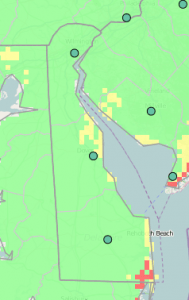Nathan Kleczewski, Extension Specialist – Plant Pathology; nkleczew@udel.edu
Stripe Rust on Wheat
Rusts are fungal pathogens that derive their name from their yellow to orange, rust-colored spores. Rusts typically are not of major concern unless disease levels are severe enough to limit photosynthesis and grain fill. We typically see leaf rust and stripe rust in Delaware, with the former more common than the latter. Stripe rust most commonly affects leaf blades and occasionally can be found on heads when disease is severe. Signs of the disease include small, round yellow/orange lesions that merge to form stripes on the leaf (Figure 1). When a symptomatic leaf is rubbed between the forefingers it will leave a characteristic yellow/orange, rust-colored powder on your fingertips. Stripe rust, unlike leaf rust, does best at cooler temperatures (60-70°F) and does not do well when temperatures increase (70-80°F). However, the disease can still develop under high temperatures with cool nights and rain. Disease development in this case will be much slower than under persistent cool, humid conditions.
We recently observed a small, localized outbreak of stripe rust on a field in Kent County and there have been reports of the disease in Virginia. Disease incidence and severity in all cases was low. At this time I would suggest fields be scouted for rust. If you observe signs of the disease on the flag leaf and your wheat has not yet flowered, you still have time to make a decision regarding treatment. If you made a fungicide treatment at boot or early heading with products such as Quilt™, Prosaro™, or Caramba™ you will have 14-21 days of rust control from the time of the application.
Figure 1. A wheat leaf with characteristic stripe rust lesions. Note how the rust runs with the leaf venation.
How can you determine if you have a rust issue that requires attention? Ask yourself these questions: 1) Is the rust on the flag leaf? 2) Has any fungicide been previously applied to the field? 3) What is the growth stage of the wheat? If you have a fair amount of rust on the flag leaves of wheat in your field, did not make a fungicide application at boot stage or early heading and plants are not past flower, then the field might benefit from a fungicide treatment. Check product labels to determine fungicide timings and preharvest intervals. Fungicides in the group 3 class (triazoles) have good activity against rust. These include Prosaro™ and Caramba™, which were mentioned last week for suppression of Fusarium head blight. If Fusarium head blight is not a concern, generic tebuconazole products may also be considered for stripe rust control.
Fusarium Head Blight Update
A long period of wet, humid weather followed by severe thunderstorms this past weekend resulted in increased risk levels of Fusarium head blight (FHB) throughout Delaware, particularly in Sussex and Kent Counties. This increased risk level only would have impacted growers who had wheat go into flowering over the weekend up until Mother’s Day (May 11-12). Those of you who just had wheat go into flower this week or are still waiting for your wheat to flower are not currently at a high risk for head scab development. The risk of FHB development in wheat that has not flowered will depend on when it flowers and if it rains. As of May 16, the scab risk has returned to low for Delaware, with the exception of a very small, southeast section of Sussex County (Figure 2). Growers are encouraged to continue to monitor the Fusasium Head Blight Risk Assessment Tool (http://www.wheatscab.psu.edu/) for changes in FHB risk levels. This tool, in combination with local weather forecasts, can help determine if fungicide applications to wheat are recommended.
Figure 2. Risk level for Delaware as of May 15, 2013. Photo obtained from http://www.wheatscab.psu.edu/.
In addition, if your wheat was in flower during the period of frost you may notice damage to heads that may resemble FHB. Suspect heads can be sent to the University of Delaware Plant Diagnostic lab for further analysis.
Past WCU articles on freezing injury to wheat may be found at:
http://cdn.sites.udel.edu/weeklycropupdate/files/2012/04/Voume15Issue3.pdf
http://extension.udel.edu/weeklycropupdate/?p=4070


